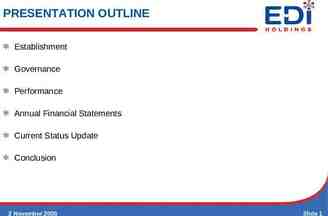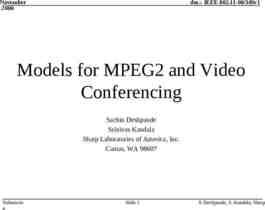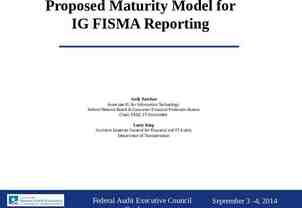Curriculum Mapping Leadership Team Planning Based on the work of
24 Slides304.50 KB
Curriculum Mapping Leadership Team Planning Based on the work of Heidi Hayes Jacobs, Ph.D. and Susan Udelhofen, Ph.D.
What Responsibilities Does the Leadership Team Have? Oversee the process Team members become the “Go To Person” for their school buildings Must know why Curriculum Mapping is important where it is going how they are going to get there Create a 3-Year Plan Administration MUST be actively involved
Administrator Support Is Crucial! Administrators must: Have a good understanding of the process Celebrate and recognize the value of the process with teachers and communicate this at every opportunity Communicate the process to school board and parents Stay abreast of the process and provide the needed leadership, support and time Be flexible and forgiving in order to learn what is taught and not taught Assure teachers during the mapping process-maps are not use for evaluation
Research-Based Principles of An Effective Learning Environment Collaboration Reflection Shared Vision for Professional Growth Student Learning The process of curriculum mapping incorporates all four principles and brings educators together to learn from their practice as they share their insights to create a positive, effective learning environment for students.
Paradigm Shift on Two Fronts Curriculum is no longer an individual choice or action - individual curriculum maps are made public shared changed modified Curriculum is never “finished” - rather it is the beginning of a dynamic process
Curriculum Mapping Is The Decision-Making Hub of the District Strategic Planning Standards Professional learning communities NCLB Teacher mentoring Literacy Critical thinking District Data Staff Development Accountability Technology
What Is Mapping? Calendar based Process for collecting data representative of the operational (real) curriculum in a school and/or district
Why Create Curriculum Maps? Locates gaps, repetitions, areas for integration,assessments Authentic alignment to standards Accountability Communication and Reflection We rarely have these conversations! Identify what occurs throughout the entire school year A picture of students’ experience from grade to grade Teacher expectations to parents and students
Mapping Process Can Improve School Culture Shared sense of purpose Opportunity to share Provides time to reflect Builds Professional Learning Communities within the school Analyze and debate to improve Increases test scores
Meaningful Assessments: Mapping Can Provide the Help Assessments clearly connected to content and skills Balanced assessments Assessment preparation for high-stakes assessments Not teaching to the test but rather teaching to the standards that will be assessed on the tests Does my curriculum reflect what is being tested and the vocabulary content that is presented? “Real World” applications Analyzing curriculum maps can help you find the answers and build a more meaningful and connected curriculum
What Information is collected on the Map? Content Skills Assessments Standards Essential Questions*
Identify Curriculum Repetitions and Gaps Recognize the difference between repetitions and redundancies Examine maps for gaps in Content Skills Standards Assessments Spiraling is the goal
Standards analysis Identifies the standards that are or are not being taught and assessed Identifies standards and curriculum alignment Defines what alignment really means Provides forum for discussion of crucial standards
The Curriculum Mapping Process Step 1: Collecting the data: each teacher creates a map individually Step 2: First read-through: teachers read each other’s maps also done individually Step 3: Small mixed group reviews: sharing findings from editing Step 4: Large group comparisons: sharing findings from small group review Step 5: Determine immediate revision points Step 6: Determine points requiring some research and planning Step 7: Plan for next review cycle
Sample Curriculum Map Template Month Essential Questions Content Skills Assessments Standards
Approximate Time MINIMUM of half day per prep K-2 Language Arts will take longer First time through will take longer First year teachers may need help
How to Continue the Work The leadership team meets three times annually for map reviews and updates
Challenges, Questions, & Issues Haven’t we done this before? Is there a right or wrong? I don’t want to do this alone. How do I know this is going to be used? This is a lot of work. How do I know what I’ll be doing in November? How can I edit fifth grade math when I am a 10th grade English teacher? What do I know about math? What if some teachers refuse?
The Best Part: The Evolution!! Collaboration Learning and talking with one another Working together to improve practice Supporting each other Reflection Identifying and focusing on key issues Analyzing and talking about “real” teacher-generated data Sharing A Vision Setting the direction for meaningful reform Student Achievement As we become better and more informed student achievement will improve “You mean I don’t HAVE to teach dinosaurs?!?”
Tailoring the Process to Your District: Dealing With Reality Teacher input School and district culture Strategic plan Deliberate timetable Available time Support and leadership at every site How to begin (one step at a time) May start small Every subject area? One site?
Sustaining the Momentum Commitment and responsibility from all teacher and administrators Student involvement Parent involvement School board support Continually (at least 3 times per year) revise and update the maps Share results Focusing on key issues Maps are basis for discussions regarding all teaching matters Use a software program Establish site-based councils
Ways to Continue the Process Hire floating substitutes In-service days Supt./Principal take class while teacher works Early release/late starts ½ day subs When teachers have time to work there must be a clear purpose and an end product that is required!!!
Making A Plan For Implementation Communicating with teachers at the onset Year one plan Year two plan Year three plan See planning template
Contact Information Region 3 Education Service Agency Platte office 337-2636 Susan Udelhofen Contact Information: 608-274 -1864 [email protected] Su-consulting.com







